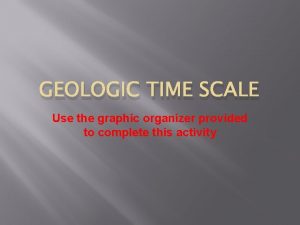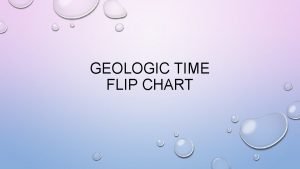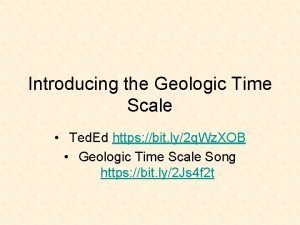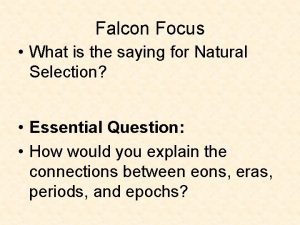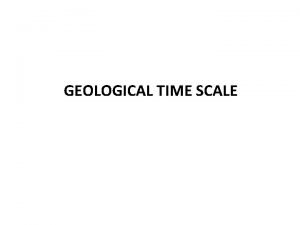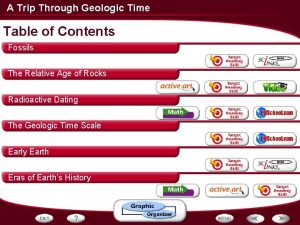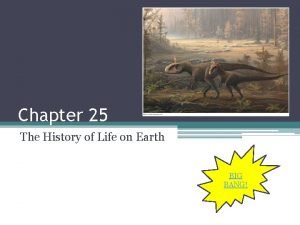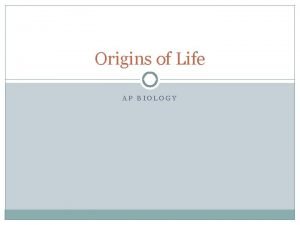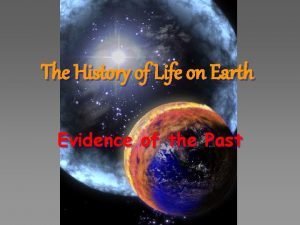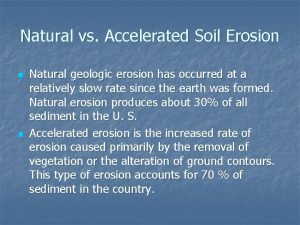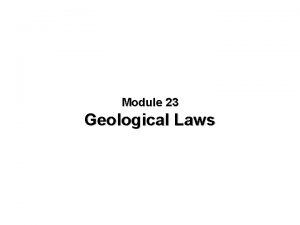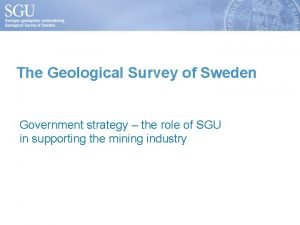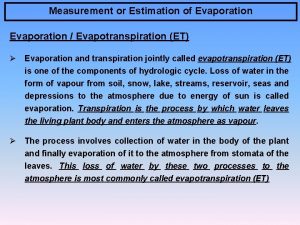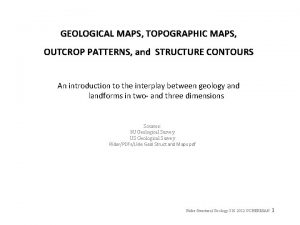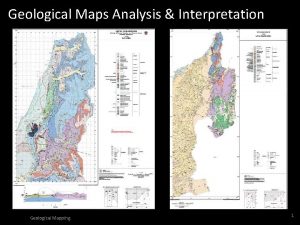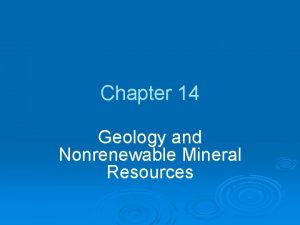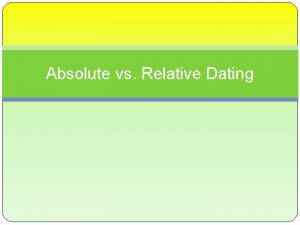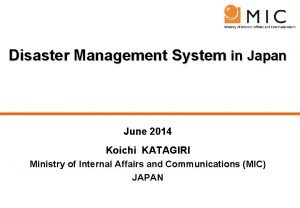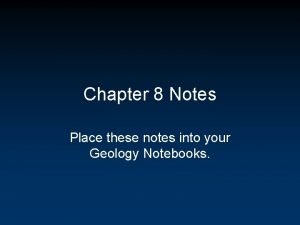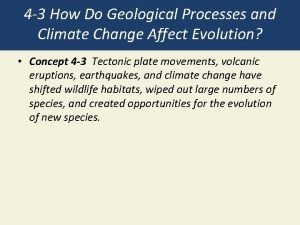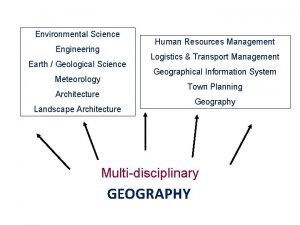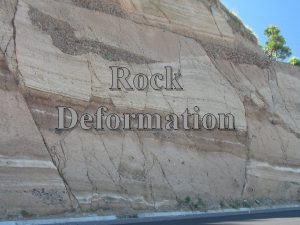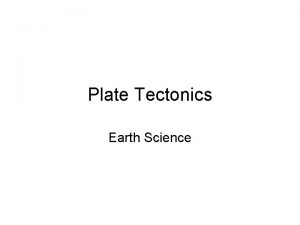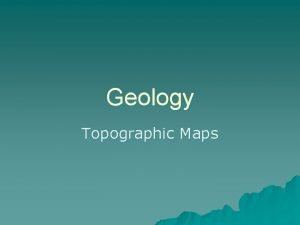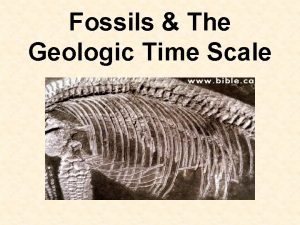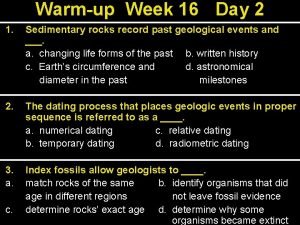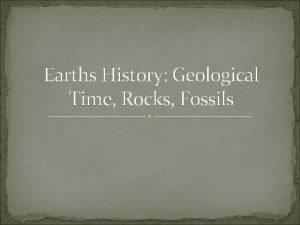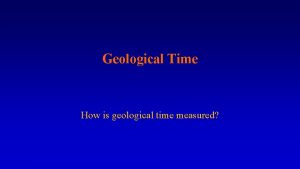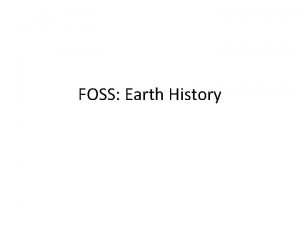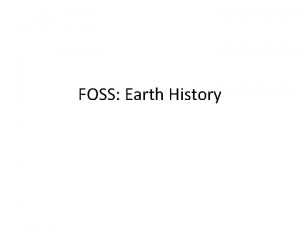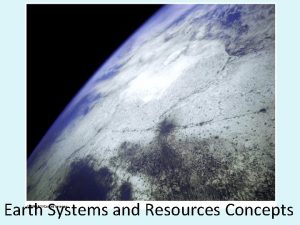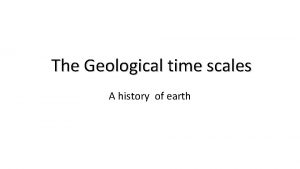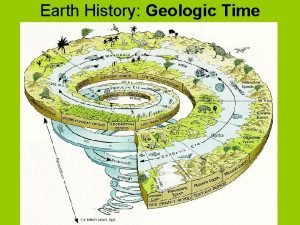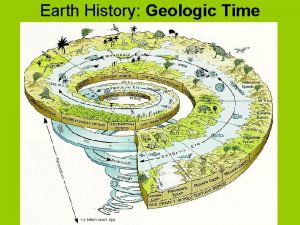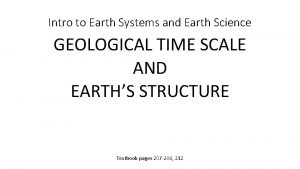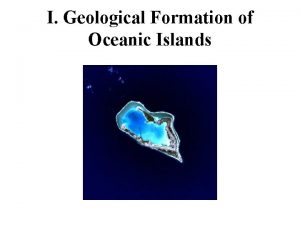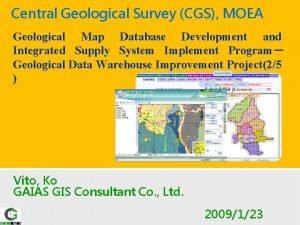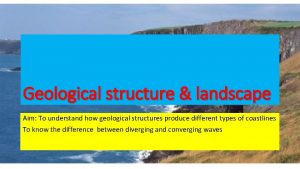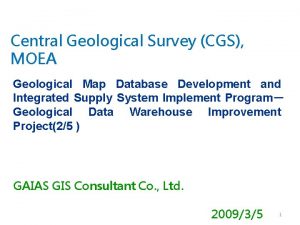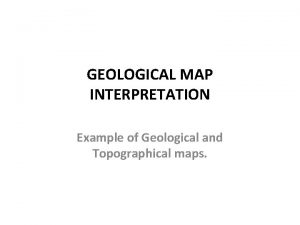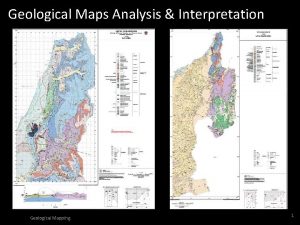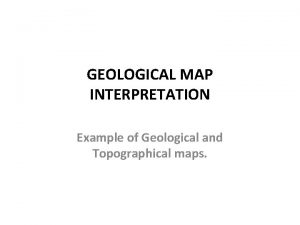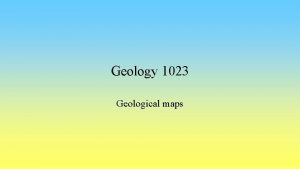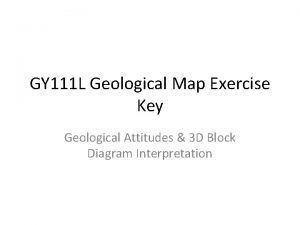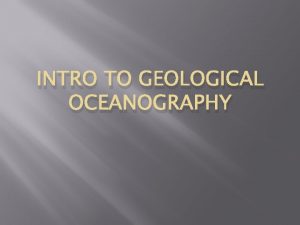History of Life on Earth The Geological Time









































- Slides: 41

History of Life on Earth The Geological Time- Scale

Agenda or Summary Layout The Geological Time-Scale 1 Discussion Item One The Geological Time-Scale 2 Discussion Item Two The Beginning of Life 3 Discussion Item Three Cambrian Explosion

The Geological Time-Scale The Earth’s Geological Time Scale

The Geological Time-Scale What does it mean? Remember that the history of life took place millions and millions of years ago. Therefore scientists had to develop a time scale that uses bigger units than century. This time scale is called the Geological Time-Scale.

The Geological Time-Scale How does it work? This time scale divides the Earth’s history into three main eras. These eras are the Paleozoic, Mesozoic and the Cenozoic. This goes back to about 543 million years ago. These eras are then divided into time periods. There about 13 time periods like Triassic, Jurassic and Neogene. Then the Cenozoic time period is divided into smaller time periods called an Epoch. Before the Cambrian period is described as the Pre-Cambrian Time.

Something for you to do. Can you answer this question? 1. Describe the time period in which you live using the geological time-scale. 2. How long ago did the Holocene Epoch begin? 3. Can you describe 10 000 years in million years?

Solution The answer is… 1. Holocene Epoch of the Quaternary Period of the Caenozoic Era. 2. 10 000 years ago. 3. 0. 01 million years ago

The Geological Time-Scale How did life begin? Scientists believe that the Earth began about 4 -6 million years ago. It was a huge ball of fire with rocks and burning gas. When it cooled, gases were released from the inside it. Hydrogen, methane, ammonia and nitrogen were the main gases. Water vapor was also present. It formed from the water that was found on the Earth’s surface.

The Geological Time-Scale How did life begin? These gases together with the water vapour formed the atmosphere. Notice that there is no oxygen. However some scientists believed that oxygen was present in very small quantities. A Russian scientist A. I Oparin and an English scientist J. B. S Haldane put forward an hypothesis about how life began in the 1920’s. They hypothesized that uv light and lightening changed these gases into organic molecules.

The Geological Time-Scale How did life begin? These organic molecules were proteins and fatty acids. These molecules combined to form the cell membranes. It is believed that this was how cells were formed. Fossil evidence suggests that cells existed from about 3. 4 billion years ago. However there is no fossil evidence on how they formed because gases and liquids do not form fossils.

The Geological Time-Scale How did life begin? The hypothesis put forward by Oparin and Haldane was tested by Stanley Miller in 1953. Miller worked under the guidance of Harold Urey at the University of Chicago. In his experiment he pumped out the air of the closed apparatus. The air was replaced with water vapour, methane, hydrogen and ammonia.

The Geological Time-Scale How did life begin? At that time Earth experienced violent storms, Miller recreated this by heating the water and passing the gases past a high voltage electric spark. The electric spark represented the lightening. After a week the contents of the flask had turned red. These contents were then removed and studied. Miller found amino acids and other organic compounds.

The Geological Time-Scale How did life begin? However there were scientist that did not support Miller’s findings. They believed that primitive Earth did contain oxygen and that the levels of oxygen were high enough to prevent the formation of organic compounds.

Life During the Pre-Cambrian Times. Before 543 million years ago The pre-Cambrian times occurred before the Cambrian Period. Scientist often describe the time or year in which a particular organism evolved or arose as the year or time period in which the first fossil appeared. The chart alongside is based on these fossil findings. 0. 5 billion of years ago Earliest Animals developed just before the Cambrian Period. 1. 5 billion years ago The earliest eukaryotes belonging to Kingdom Protista. They were mainly unicellular. Around 2. 5 billion years ago Amount of oxygen in atmosphere increased due to the photosynthetic bacteria. About 3. 5 billion years ago earliest life forms were prokaryotes. They were photosynthetic. About 4. 5 billion years ago the formation of the Earth.

Something for you to do. Answer this question. Can you do this?

The information shown in the chart in the can be translated into a time line. 0. 5 - Earliest Animals 1. 0 - Billions of 1. 5 - Earliest prokaryotes years ago 2. 0 - 2. 5 - Accumulation of oxygen 3. 0 - } different types of bacteria 3. 5 - Prokaryotes (photosynthetic bacteria) 4. 0 - Possible origin of earliest life forms 4. 5 - Formation of Earth

The Cambrian Explosion The animal explosion. This period lasted for about 38 million years It started 543 million years ago and lasted until about 505 million years ago. The most notable happening during this period was the explosion of the animal groups. The animals suddenly appeared in the first 5 to 20 million years. These animals appeared on Earth in a very short period of time.

The Cambrian Explosion The animal explosion. The fossil record shows the major animal groups appeared as follows: the coelenterates • sponges • molluscs • arthropods • chordates • annelids • echinoderms • 520 million years ago 540 million years ago 536 million years ago 513 million years ago 524 million years ago 520 million years ago 518 million years ago

End of the Cambrian times to the modern period History of life from the end of the Cambrian period to the Holocene Epoch The epoch in which we now live is called the. Holocene epoch. We shall now look at the history of life from the end of the Cambrian time until the modern epoch. Based on fossil records scientists think that the following organisms appeared as follows: • fish about 438 million years ago • amphibians about 380 million years ago • reptiles about 385 million years ago • birds about 180 million years ago • mammals about 150 million years ago • humans about 150 000 to 200 000 years ago

End of the Cambrian times to the modern period Human history The first bipedal animals of the human family appeared about 2 million years ago. According to the fossil records there were many species of these bipedal ape- like ancestors. They showed a gradual increase in height, brain size and a gradual flattening of the face. It is believed the earliest ape-like ancestors of humans lived millions of years ago in Africa.

Terminology These are the terms you must know Geological Time-Scale: the time scale that is used to trace the history of life. Eras: these are the time period in which the Earth’s history is divided into. Time periods: are the smaller time periods that the eras are divided into Epoch: is the smaller time period into which the time periods of the Caenozoic Era is divided into. Pre-Cambrian Time : is the period before the Cambrian period.

Something for you to do 1. The three main Eras of Earths history. A. B. C. D. Paleozoic, Mesozoic and Caenozoic Holocene, Paleozoic and Triassic Quaternary, Mesozoic and Triassic Caenozoic, Triassic and Paleozoic

2. The periods of the Caenozoic Era is called… A. B. C. D. Era Time period Epoch Cambrian

3. The gases found on Earth 4 -6 billion years ago… A. B. C. D. Oxygen, methane and nitrogen Hydrogen, carbon and oxygen Hydrogen, methane and ammonia Nitrogen, oxygen and water.

4. The two scientists that hypothesized that uv light and lightening changed the gases found on earth into organic molecules are… A. B. C. D. Miller and Urey Oparin and Haldane Oparin and Urey Miller and Oparin

5. The scientist that tested the above hypothesis was called… A. B. C. D. Miller Oparin Urey Haldane

6. The earliest life forms of the pre-Cambrian times were… A. B. C. D. Prokaryotes Eukaryotes Humans Fish

7. The earliest eukaryotes developed about ___ years ago. A. B. C. D. 0. 5 1. 5 2. 0 4. 5

8. The organism that was responsible for releasing oxygen into the atmosphere during the pre. Cambrian times were… A. B. C. D. Fungi Plants Photosynthetic cyanobacteria

9. The first organisms of the animal kingdom appeared ____ thousand years ago. A. B. C. D. 200 150 610 300

10. The Holocene belongs to the _____ period. A. B. C. D. Quaternary Neogene Palaeocene Triassic

11. The Neogene period is a part of the ___ era. A. B. C. D. Caenozoic Mesozoic Paleozoic None of the above.

12. The Cretaceous period began about ___ million years ago. A. B. C. D. 4500 0. 01 144 208

13. The gas that was in extremely small quantities or completely absent when life on Earth began. A. B. C. D. Methane Hydrogen Ammonia Oxygen

14. The gas that increased in the Earth’s atmosphere when the photosynthetic bacteria developed. A. B. C. D. Methane Hydrogen Ammonia Oxygen

15. The geological time period that we are now living in. A. B. C. D. Quaternary Neogene Palaeocene Triassic

16. The geological time period in which the major groups of animals appeared. A. B. C. D. Cambrian Triassic Jurassic Permian

17. The geological time period when the dinosaurs flourished. A. B. C. D. Cambrian Triassic Jurassic Permian

18. The oldest phyla of invertebrates that appeared on Earth. A. B. C. D. Coelenterates Sponges Molluscs Arthropods

Solution: 1. 2. 3. 4. 5. 6. 7. 8. A C C B A A B C

9. 10. 11. 12. 13. 14. 15. 16. 17. 18. C A A C D D A A C D
 Geological time scale graphic organizer
Geological time scale graphic organizer Rubric for designing geological time scale
Rubric for designing geological time scale Jurassic coast map
Jurassic coast map Geological time scale
Geological time scale Geological time scale with events
Geological time scale with events Geological time scale
Geological time scale A trip through geologic time answer key
A trip through geologic time answer key Chapter 25 the history of life on earth
Chapter 25 the history of life on earth Aerobic bacteria
Aerobic bacteria Tuzo wilson
Tuzo wilson Plate tectonics vs continental drift
Plate tectonics vs continental drift Geographical influence on architecture
Geographical influence on architecture Differentiate between geological and accelerated erosion
Differentiate between geological and accelerated erosion Module 23
Module 23 J fred muir memorial scholarship in science
J fred muir memorial scholarship in science Geological map sweden
Geological map sweden Factors affecting evapotranspiration
Factors affecting evapotranspiration Outcrop patterns geology
Outcrop patterns geology Geological map interpretation
Geological map interpretation Geological processes
Geological processes Define relative dating
Define relative dating Geological disaster example
Geological disaster example Geological events
Geological events How do geological processes affect natural selection
How do geological processes affect natural selection What did geological engineers invent
What did geological engineers invent Geological
Geological Stress faults
Stress faults Divergent boundary geological features
Divergent boundary geological features Whats a contour interval
Whats a contour interval Tertiary age
Tertiary age Sedimentary rocks record past geological events and ____.
Sedimentary rocks record past geological events and ____. Elapsed time
Elapsed time Hát kết hợp bộ gõ cơ thể
Hát kết hợp bộ gõ cơ thể Slidetodoc
Slidetodoc Bổ thể
Bổ thể Tỉ lệ cơ thể trẻ em
Tỉ lệ cơ thể trẻ em Gấu đi như thế nào
Gấu đi như thế nào Tư thế worm breton là gì
Tư thế worm breton là gì Chúa yêu trần thế alleluia
Chúa yêu trần thế alleluia Các môn thể thao bắt đầu bằng từ đua
Các môn thể thao bắt đầu bằng từ đua Thế nào là hệ số cao nhất
Thế nào là hệ số cao nhất Các châu lục và đại dương trên thế giới
Các châu lục và đại dương trên thế giới
